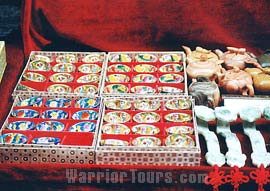Cloisonne

As a shining pearl in the art and craft world, cloisonné is one of the four famous crafts (the other three are carved lacquer ware, jade and ivory) in Beijing. It enjoys tremendous fame both at home and abroad, with its long history, elegant sculpting, thunder-and-lightning color and varied patterns. Cloisonné articles offer exquisite decorations for houses, popular gifts as presents for relatives and friends, and awards and souvenirs as praise and honor.
Cloisonné, also named enamel, is a special craft combining porcelain and copper. Created during the reign of Jingtai of the Ming Dynasty (1368-1644), it was only made in blue at first, so it was named 'Jingtai blue'. Cloisonné objects were commonly seen and well developed during the Jingtai and Chenghua reigns of the Ming Dynasty. For a period after that, they were still made but without improvement and couldn't be compared in quality with those made before. In Qianlong's reign of the Qing Dynasty (1644 - 1911), cloisonné objects were again made in a great number and variety, and they were just second to those of the Jingtai and Chenghua times. After that, cloisonné items become just old fashioned copper vessels.
![]() Cloisonné of Different Times
Cloisonné of Different Times
The best cloisonné was made in the Ming Dynasty, with good quality copper. Most of them were made with red copper looking a little thick and heavy and the colored glaze used natural minerals, looking bright and lifelike. Cloisonné of that time used primitive filigree, had thick gilt, and had air bubbles in the colored glaze.
Cloisonné of the Qing Dynasty used delicate colors, graceful filigree, and fine glazes with no air bubbles. Besides, the scope was enlarged beyond the sacrificial/household wares into vases, folding screens, incense burners, tables, chairs, chopsticks, and bowls. Meanwhile, varied patterns were used, but they are not as vivid as those of the Ming Dynasty.
In the Republican Period of China, the quality of cloisonné became inferior to those of former times. Most of the cloisonné objects were made roughly without innovation.
At present, the techniques of making cloisonné have been improved immensely and all kinds of cloisonné crafts are made. They have become the best present for relatives and friends nationally and internationally.
![]() Cloisonné Making
Cloisonné Making
"A crystal of the ancient working men's wisdom", cloisonné is a combination of many traditional crafts, including the crafts of making bronze and porcelain and the arts of painting and sculpture. To make a delicate cloisonné object, over 30 operations are needed. The five main steps are as follows:
First, model hammering – Cutting and hammering the red copper pieces into different shapes accordingly, and then joining each part together into the required shape under high temperature to form the model.
Second, filigree nipping – nipping and patching the thin brass wires into delicate patterns, and then pasting them on to the model to form different partitions, finally heating it to 900 degrees centigrade (1652 F) to weld the patterns firmly to the model.
Third, enamels filling – after covering the model with patterns of filigree and rearranging the filigrees, enamels are painted into the partitions of the filigrees. After fusing the powdery glaze with a heat of 800 degrees centigrade (1472 F), it is taken out and the process is repeated three or four times until the surface becomes smooth.
Fourth, surface polishing – using grit, brimstone, and charcoal in order; the rough glaze is rubbed down. Each of the partitions of the object has to be filled with glaze, fused, and polished time and time again. In addition, those filigrees standing above the glaze also have to be ground and rubbed down finally with charcoal and drawknife so the whole surface becomes smooth. It does need patience and care.
Fifth, Gilding – after acid cleaning, decontamination, and sand scouring the semi-finished article is put into a tank filled with gilding liquid, an electric current is then put through the tank. Several minutes later, when the liquid has gold adhered on the surface of the metal part of the cloisonné, it is taken out. After washing and drying, a bright-colored dazzling craft of cloisonné will appear.
![]() Cloisonné Discriminating
Cloisonné Discriminating
The best cloisonné was made in the Ming Dynasty, but you have to check it carefully and in detail. The main characteristics of the Ming Dynasty's cloisonné are as follows:
Material – perfectly clear
Capability – similar to the glass
Filigree – brass
Surface – a little bit rough with air bubbles
Color – most are glossy green, some are bright red, bright purple, dark blue, silvery white, light greenish blue and dark yellow.
Qing Dynasty's cloisonné objects are less bright, visually, and red copper filigree is used. The best are mostly in yellow and white.

